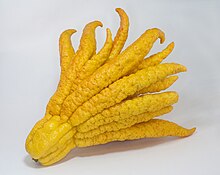Variety of fruit
| Fingered citron
|

|
| Buddha's hand fruit, "open hand" appearance when ripe
|
| Scientific classification
|
| Kingdom:
|
|
| (unranked):
|
|
| (unranked):
|
|
| (unranked):
|
|
| Order:
|
|
| Family:
|
|
| Genus:
|
|
| Species:
|
|
| Variety:
|
C. m. var. sarcodactylis
|
| Trinomial name
|
Citrus medica var. sarcodactylis
(Hoola van Nooten) Swingle
|
Citrus medica var. sarcodactylis, or the fingered citron, is a citron variety whose fruit is segmented into finger-like sections, resembling those seen on representations of the Buddha. It is called Buddha's hand in many languages including English, Chinese, Japanese, Korean, Vietnamese, and French.
The different cultivars and variations of this citron variety form a gradient from "open-hand" types with outward-splayed segments to "closed-hand" types, in which the fingers are kept together. There are also half-fingered fruits, in which the basal side is united and the apical side fingered. The origin of this kind of citron is commonly traced back to South or East Asia, probably northeastern India or China, where most domesticated citrus fruits originate.[1]
- ^ Karp, David (Winter 1998). "Buddha's Hand Citron". Flavor and Fortune. 5 (4). Kings Park, NY: Institute for the Advancement of the Science and Art of Chinese Cuisine: 5–6. Archived from the original on 2011-06-06. Retrieved 2010-04-20.

